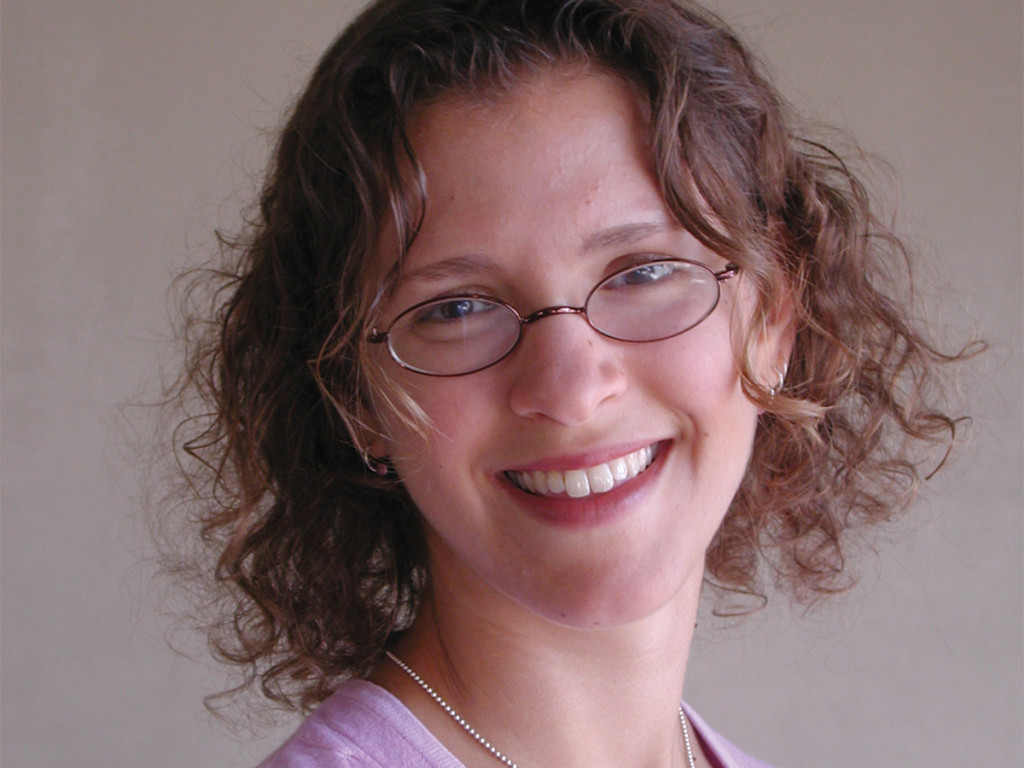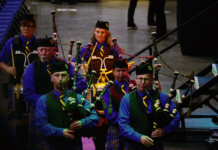
Associate Professor of Dance Anthea Kraut is creating ripples through American dance studies with her second book, “Choreographing Copyright: Race, Gender, and Intellectual Property Rights in American Dance,” which was published by Oxford University Press in 2015. The book has gone on to receive numerous awards, including the 2015-2016 Emory Elliott Award, for its extended efforts in connecting the history of American dance to U.S. copyright law. At UCR, she is a dedicated dance history teacher who emphasizes the importance of analyzing what is not seen or traditionally taught, including being able to have a critical eye in both the dance studio and the academic classroom.
Professor Kraut: I started as a dancer. Dancing was my number one passion but was always separate from school. In college, my school had one dance history class and it was a black dance history class. I realized in that class that my favorite dance form, which was jazz dance, was an African-American dance form. I was angry that no one had ever taught that to me, and that launched my interest in learning more about dance history. Other scholars also helped open my eyes to the ways African-American influences have become invisibilized in American dance.Jasmine: How did you get your start in dance history? Was it the physical movement of dance itself that brought you into the field or were you more fascinated in its history initially?
Jasmine: What do you think is the reason why so many African-American dance forms have been copyrighted or endowed credit to someone else?
Professor Kraut: This is due to a two-part problem: A lot of the problem is ignorance, given that dance history is not usually taught alongside dance practice. So it’s not very common to learn the history behind any dance forms. And these were mostly white dance studios that I was attending. That’s the way white privilege works — you’re not really responsible for knowing where the movements you are performing come from — and it’s widespread. We also tend to think of dance as separate from politics, but dance is actually implicated within politics, especially and including racial politics.
Jasmine: How does the term “copyright” apply to your book, “Choreographing Copyright: Race, Gender, and Intellectual Property Rights in American Dance,” which won the 2015-2016 Emory Elliott Book Award?
Professor Kraut: One way is through the notion of property itself. I see both the notion of property and the law as sites through which dancers try to negotiate their status, especially in terms of race or gender. One thing I encourage is to not only view race through the lens of physical characteristics but also as a way of regulating the relationship between the body and what that body produces. Rights are one place where we can see racial hierarchies enacted, especially when you think about the history of slavery and the legal treatment of black bodies as property.
Copyright is a form of intellectual property, and interest in it cuts across dance genres. The book looks at early modern dance, jazz, tap dance, dance on Broadway and contemporary dance. On one hand, it pushes on the ways we think about whiteness and white privilege, and, at the same time, it tries to recover examples of dancers of color who have also sought property rights in their dances.
For example, a South Asian dancer named Mohammed Ismail sued one of the most famous white early modern dancers named Ruth St. Denis. Ismail claimed that she owed him money because he taught her one of the so-called “oriental” dances that she was getting famous for around 1909.
St. Denis, because she has been so celebrated in American dance history, has archives around the country but there are no archives for Mohammed Ismail. History is a record of people who are victorious, as the saying goes, and Ismail becomes just a footnote in her archives. It’s interesting because St. Denis herself became anxious about others reproducing her dances, but she was reproducing Mohammed Ismail’s work. This seems to be a pattern across history. So, Ruth St. Denis had good reason not to advertise the fact the she was sued, and that silence is part of the reason it’s so hard to find more information about Ismail.
Still, his example shows that dancers of color have seen the law as one of the avenues through which they can resist white supremacy. The only evidence I could find for that case was through three small newspaper articles that survived in the archives. Legal archives are always going to be skewed toward dominant white interests, so it’s also important to learn as much as we can about marginalized dancers and to look beyond traditional archives and to read against the grain.
Jasmine: Your book is deemed as the “first book by a dance scholar to focus explicitly on matters of copyright and choreography” … Therefore, was it difficult obtaining the information that you include in the book? How did you perform your research — through historical documents? Interviews?
It’s such a challenge to get information about some of these cases. I was kind of looking for the untold parts of dance history, and that’s always the challenge of archives. Archives reflect larger power structures so I was trying to recover the efforts of dancers who weren’t already famous. Yes, it was challenging but I guess that’s what draws me to it. Looking for what we don’t already know about dance history and about marginalized dancers and their untold stories — I feel like those stories might help us rethink our assumptions about how we got here and the ways we think about dance today.
Jasmine: What was a difficulty that you encountered while compiling your information through the archives?
Professor Kraut: I didn’t want it to just be a history of white women, so I had to work to piece together fragmented bits of evidence related to dancers of color who were interested in protecting their expressive output. It’s important for a dance historian not to let the fact that evidence is fragmented to deter them from considering something as part of the story. Our job is to piece fragments together and to really think about their significance even when you don’t have the full picture. You have to accept there’s never a complete picture but it’s the tidbits that can prompt you to think differently.
One thing I encourage is to not only view race through the lens of physical characteristics but also as a way of regulating the relationship between the body and what that body produces. Rights are one place where we can see racial hierarchies enacted, especially when you think about the history of slavery and the legal treatment of black bodies as property.
Jasmine: What advice would you lend to someone who may resort to the same method of research (by browsing through archives and historical documents)?
Professor Kraut: Learn to read critically — whether bodies or texts — and to view absences as being just as important as presences. What might be left out and what’s there should both be read with a critical eye. It’s crucial to learn to see the power structures in the archives and to learn about how power has been contested and negotiated. That’s why working with primary sources is so exciting because you get to analyze what’s there and what’s not there rather than not just relying on someone else’s word for it. I guess that’s one of the things you also learn from dance: It’s impossible to assign any one, single meaning to dance. Dance doesn’t use words to express itself. It’s a bodily language, and the idea that any one move could mean any one, exact thing just doesn’t work in dance. Dance forces you to think about meaning as being multiple, and that’s a useful lesson for any student in the humanities to bear in mind.
Jasmine: In your dance history class, what is the takeaway lesson you try to teach your students?
Professor Kraut: First and foremost, try to think critically about dance — any dance you encounter, participate in and witness. Instead of viewing it as being purely about fun and thinking of it as superfluous, consider dance as a demonstration of power relationships. The same race and gender dynamics that are enacted in broader culture are actually playing out within our bodies. Pay attention to what’s happening in terms of bodies and power. Also, it’s important to always be questioning what we think we know and to become intellectually curious about what you’re being given, whether it be a dance move you’re being taught in a dance studio or a statement about history.
Another takeaway is to take seriously the responsibility that we have to learn the history of the dances we encounter and to recognize what an enormous influence African-Americans have had on American dances. I think our knowledge about dance is much too limited, and even with something popular on campus like hip-hop dance, I still think that most people who do it don’t exactly know the history of that form. Not that they’re completely ignorant about its history, but there’s not enough awareness of where hip-hop dances come from: From black and Latino communities in the Bronx in the 1970s. More broadly speaking, African-American influences can be seen on an incredibly wide array of dance forms — modern, ballroom, hip-hop. It’s not just in jazz. It’s really across the board.
Jasmine: How has your students’ pre-existing knowledge of dance impacted your own perception of modern dance?
Professor Kraut: Students at UCR help underscore the importance of giving value to all forms of dance instead of thinking of ballet and modern as the only legitimate forms of dance worth studying in a university setting. A lot of students at UCR have some relationship to dance and are practitioners of some sort of social dance. It is a connection to family, friends and heritage for a lot of students. Even though we may not learn the histories behind the dances we practice, knowledge is being transmitted through those dances in everyday social experiences, in people’s childhoods, in their communities.
Jasmine: Considering UCR is such a diverse school and with many students bringing in their personal and cultural connections with dance to campus, what has been your favorite aspect of the dance culture that has formed within UCR?
Professor Kraut: All of my colleagues in the Department of Dance emphasize the need to recognize the values inherent in all kinds of different dance forms rather than privileging only some as legitimate or important. I think that we’re really trying to level the playing field and not perpetuate the hierarchies that have structured American dance.
At UCR, both faculty and students have forced attention to multiplicity in dance and to thinking about how we can challenge hierarchies. If we think about dance as knowledge, then there is a way we can value the wealth of information that is contained in all the different dances performed by different bodies … And we should be able to treat the study of dance and its histories as just as important as the study of novels and traditional history.








